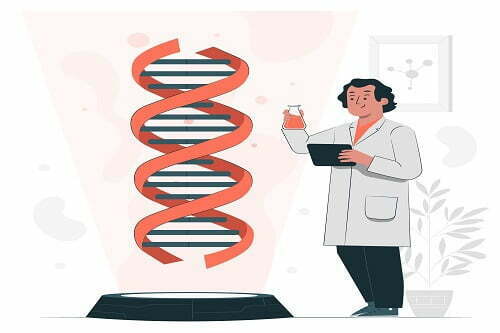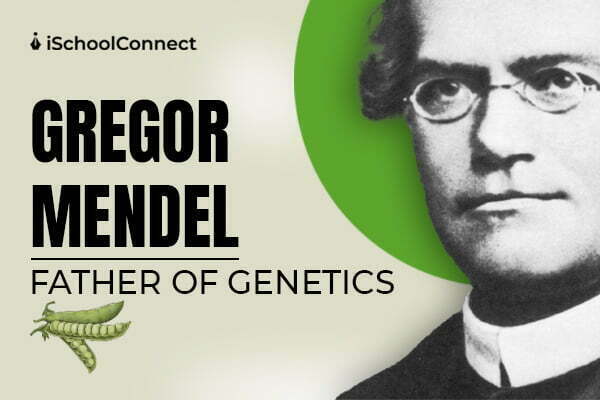Table of Contents
Gregor Mendel’s work, like that of many other great thinkers, was not appreciated until after his death. People knew him as a pleasant man who was fond of flowers and as someone who kept accurate weather and star records.
From living in a financial crunch, working as a gardener, to becoming the father of genetics, Mendel’s life story is worth a read. So, keep scrolling to learn all about this gem of a personality.
Father of Genetics- A brief!

Gregor Mendel was born in 1822 in Hynice (Heinzendorf bei Odrau in German) to Anton and Rosine (Schwirtlich). Veronika, his older sister, and Theresia, his younger sister, were his only siblings. They lived and worked on a farm owned by the Mendel family for more than 130 years.
His family always valued education but lacked the financial resources to send him to school. Therefore, Mendel did various jobs to make ends meet. Mendel worked as a gardener and learned beekeeping in his childhood and used to go to an Opava gymnasium when he was young.
From 1840 until 1843, he studied practical and theoretical philosophy and physics at the Philosophical Institute of the University of Olomouc. His sister, Theresia, helped him pay for his studies. Later, he helped raise her three children, two of whom became doctors.
The young monk
Let’s read how the father of genetics became a young monk and a teacher.
- Mendel captivated the Augustinian monks in Brunn (now Brno), who valued science, study, and education. His professor thought he would be a good fit because of his talent in physics and math. Despite his reluctance to become a monk, his professor accepted Mendel into the order on September 7, 1843.
- Mendel failed the teaching certificate examination twice but the University of Vienna allowed him to continue his education. He discovered his skills for teaching at this university. Besides this, he spent most of his time in the monastery’s botanical garden, growing fuchsias and pea plants.
Love for peas
Mendel had no intention of conducting the first well-controlled and superbly designed genetic studies. His purpose was just to experiment with hybrid pea plants and see what would happen. But, his discoveries prompted other studies, which resulted in remarkably foresighted conclusions-
- Mendel developed the Laws of Inheritance.
- He coined the phrases dominant and recessive.
- Also, he was the first to apply statistical tools to assess and forecast hereditary information by simply counting peas and making precise notes.
Mendel cultivated thousands of pea plants for eight years, methodically transferring pollen from one plant to another with a paintbrush to make his crosses (while still attending to his duties as a monk and a teacher).
Contributions

The father of Genetics, Gregor Mendel, has made significant contributions, leading to various crucial discoveries. Read all about those contributions here.
1. Experiments on plant hybridization
Mendel examined seven features inherited independently of other traits after first trials with pea plants. These were-
- Form of the seed
- Blossom color
- Seed coat tint
- Shape of the pod
- Unripe pod color
- Flower location
- Height of the plant
Mendel farmed and tested around 28,000 plants between 1856 and 1863, the majority of which were pea plants (Pisum sativum). He experimented by crossing true-breeding distinct kinds and concluded three things from this study-
- One in four pea plants exhibited purebred recessive genes.
- Two out of four were hybrids.
- One out of four were purebred dominant in the second generation.
Mendel derived the Laws of Inheritance from his experiments, along with the Law of Segregation and the Law of Independent Assortment.
2. Initial reception
On February 8 and March 8, 1865, Mendel presented his work “Versuche über Pflanzenhybriden” (“Experiments on Plant Hybridization”) at two sessions of the Natural History Society of Brno in Moravia. It received a few press reports in local newspapers, but the science community largely ignored it.
When Mendel’s study was published in Verhandlungen des naturforschenden Vereines in Brünn in 1866, people viewed it as mostly about hybridization rather than inheritance. Consequently, it didn’t create an impact and was only quoted three times over the next 35 years.
Notably, Charles Darwin was unaware of Mendel’s publication, but if he had been aware, genetics, as we know it today, would have emerged much sooner. Thus, Mendel’s scientific life serves as an illustration of how people overlook highly creative innovators.
3. Rediscovery

Approximately forty scientists attended Mendel’s two groundbreaking talks, yet they did not comprehend his work. Later, he corresponded with Carl Nägeli, one of the prominent scientists of the period, but Nägeli did not see the significance of Mendel’s discoveries.
Mendel may have had concerns about his work, but he assured that his time would come. During Mendel’s lifetime, most biologists believed that the next generation got all the features by blending inheritance, which involved averaging the traits of each parent. Today, scientists are using the operation of numerous genes with quantitative effects to explain instances of this phenomenon.
4. The Mendelian paradox
In 1936, Ronald Fisher, a well-known statistician, and population geneticist reconstructed Mendel’s experiments. He analyzed F2 (second filial) generation results and discovered that the ratio of dominant to recessive phenotypes (e.g. yellow versus green peas; round versus wrinkled peas) was implausibly and consistently too close to the expected ratio of 3 to 1.
“Most, if not all, of the trials’ findings, have been manipulated,” Fisher stated. Mendel’s stated observations were abominable, startling, and cooked, according to Fisher.
5. Unrecognized brilliance
On February 8, 1865, Mendel presented his findings to the Brunn Society for Natural Science. His paper “Experiments on Plant Hybridization” was published the following year.
In the years after his work was published, Mendel was still trying cross-breeding experiments with hawkweed and bees. Eventually, he became a meticulous record-keeper of meteorological and astronomical data.
Mendel just had enough time to complete his meteorological and apicultural research by 1871. His last years were horrible due to Bright disease, and he died at the age of 61.
What’s next?
Gregor Mendel was oblivious to the new science of genetics that he helped to establish. While people praised his work for its thoroughness, no one realized its significance. His works were simply too much ahead of their time, and they went against conventional beliefs about heredity.
We hope you enjoyed reading about the father of genetics and the contributions he made to the world. You can share your thoughts about the blog by dropping a comment below. Alternatively, feel free to reach out to us!
FAQs
Q1. What were Mendel’s three most significant discoveries?
Answer- Known as Mendelian inheritance, he proposed numerous basic genetic rules, including the Law of Segregation, the Law of Dominance, and the Law of Independent Assortment.
Q2. What was Mendel’s most important work in genetics?
Answer- Gregor Mendel uncovered the fundamental laws of inheritance through his research on pea plants. He deduced that genes are inherited in pairs and as separate units, one from each parent. Mendel studied the segregation of parental genes and their presentation as dominant or recessive traits in the offspring.
Q3. What is the significance of Gregor Mendel to scientists today?
Answer- Mendel’s findings laid the groundwork for contemporary genetics and the study of heredity, and people call him a genetics pioneer.
Q4. Did Gregor Mendel receive any awards?
Answer- In 1868, Gregor Mendel was chosen vice president of the National Science Society. Besides, in 1872, the jury nominated him for the Order of Franz Josef, and he received the Medal of the Heitzing Horticultural Society.






